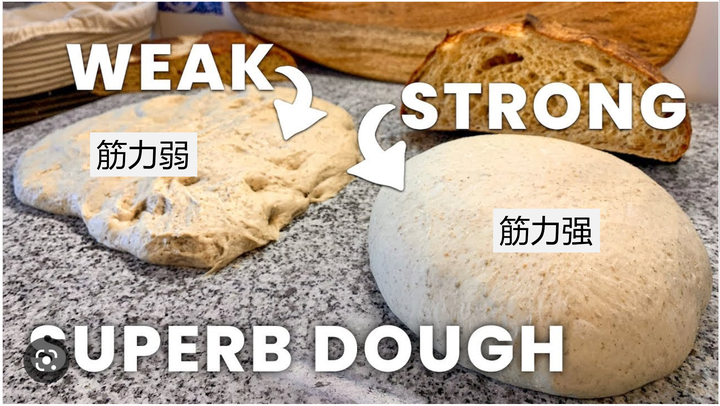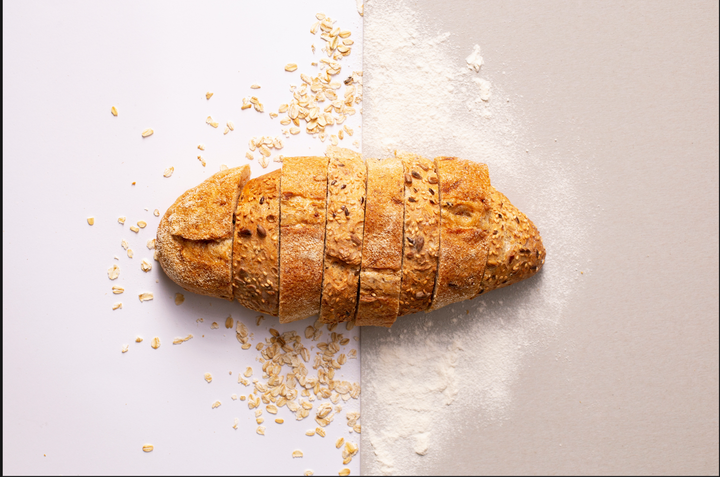The difference between high-gluten, medium-gluten, and low-gluten flour lies in the “gluten”.
This “gluten” refers to the gluten strength of the dough , for example:
Some dough is firmer and can “stand” on the table by itself; while some dough is softer and can “spread” on the table.
The former has high gluten strength, which corresponds to “high-gluten flour”; otherwise, it corresponds to “low-gluten flour”.

If we are not satisfied with the answer of “the difference between flour is in gluten strength”, we can dig a little deeper:
Why do different flours have different gluten strengths?
The answer is that the “quality” of protein is not the same .
Proteins that have a direct effect on gluten strength account for only a small fraction of flour proteins, about 5-10%.
It’s called glutenin, a macromolecular glutenin , and it’s the most important component of gluten — the greater its proportion, the more gluten is formed.
In other words, the larger its proportion, the higher the “quality” of the protein.

Therefore, the core difference between high-gluten, medium-gluten and low-gluten flour is the quality of protein.
High-gluten flour is flour with a large proportion of macromolecular glutenin and good protein quality; otherwise, it is low-gluten flour.
Protein content also has an effect on gluten strength, but less than protein “quality”.
For example, for the same high-gluten flour, the protein content of 12.5% may be better than that of 13.5%.
In practical applications, it does not mean that high-gluten flour is better than low-gluten flour, and different protein levels correspond to different applications .
All-purpose flour has moderate gluten strength and is suitable for making Chinese pastries , such as steamed buns, buns, ramen, dumplings, etc. It is also the most commonly used flour at home.
The dough used to make ramen and pancakes needs to be stretched, which requires higher extensibility. It is a slightly special all-purpose flour.

High-gluten and low-gluten flour are more used in Western-style pastries .
High-gluten flour has better support and ductility, and is suitable for making bread; if the support is insufficient, the dough will easily collapse during fermentation.
Low-gluten flour has relatively poor support and ductility, and is suitable for making pastries that melt in the mouth and are fragile, such as cakes and biscuits.
If you use inverted flour, you’ll end up with chewy cakes, cookies, and bread that won’t rise. .
In addition, another reason why flour is confusing may be that there are too many names.
Such as rich and strong flour, special first flour, special second flour, medium-gluten flour, low-gluten flour, wheat core flour, dumpling flour, etc., all kinds of flour are indistinguishable.
In fact, there are several sets of classification systems in it, which naturally makes people feel confused when they are mixed together.
These naming systems are also related to the development of flour.
The first system and the earliest system are named after the powder yield , such as Fuqiang powder, special first powder, special second powder, 70 powder, 80 powder, etc.;
The logic is the same wheat, the lower the flour extraction rate, the more “finish” the flour, the better the quality, and the more expensive the price;
This can also show the characteristics of the “seller’s market” back then, because the logic of naming is related to the production process (from the producer).
Later, the production and sales of flour transitioned to a “buyer’s market”, consumers began to have the right to speak, and a second naming system gradually emerged.
That is, the system named after “tendon” mentioned in our title.
The naming logic comes from the flour user, and the names correspond to different dough characteristics.
For example, the medium-gluten flour mentioned above is suitable for making steamed buns and buns, and the low-gluten flour is suitable for making cakes and so on.
Up to now, the production and sales of flour have become a complete “buyer’s market”, and the characteristics of flour have also been further refined.
Therefore, a third naming system has appeared, which is directly named after the purpose, which is more convenient for consumers to choose.
The medium-gluten flour is divided into steamed bun flour, dumpling flour, pulled flour, cold skin flour and so on.
What’s more interesting is that steamed bun powder is divided into northern steamed bun powder and southern steamed bun powder, and even southern steamed bun powder in Jiangsu is different from southern steamed bun powder in Guangdong.
There are also some nouns that are not in the nomenclature:
- Wheat flour : it means flour (flour is made of wheat;
- Wheat core flour, special refined flour : marketing words, which have nothing to do with the quality characteristics of flour;
- Hetao flour, five-star/six-star/eight-star flour : the brand name or place of origin has nothing to do with the quality characteristics of the flour;
- Whole wheat (flour) flour : flour containing wheat bran, the gluten strength will be slightly weaker than that of white flour of the same level, and it is generally used in a 1:1 mixture with white flour;
- Self -raising flour: flour that will “raise” by itself without adding dry yeast;
- Pre- mixed xx powder : the semi-finished product that is pre-mixed with sugar, salt, yeast, and improver into the flour, which can be used to directly make xx flour;
- General-purpose (flour) flour, multi-purpose (flour) flour : It means “general-purpose”, generally medium-gluten flour, suitable for making Chinese-style pastries such as steamed buns, steamed buns, and dumplings;
So, how do we consumers choose?
Now the first set of naming systems, such as rich and strong powder, special one powder and so on are basically very few, most of the flour is named after “gluten” or its purpose.
The first set of named words can be omitted directly, such as Fuqiang medium-gluten wheat flour, which is medium-gluten wheat flour.
Everyone can buy according to their own needs.
- For example, to make steamed buns, buy all-purpose flour, or buy steamed bun flour and steamed stuffed bun flour;
- Buy low-gluten flour or cake flour for cakes;
- If you don’t need to add dry yeast, you can buy self-raising flour;
- If you need to use it directly to make cakes, buy pre-mixed cake flour.
In addition, the specific usage of these flours, I see that the answerer under this question has said it in detail, so I won’t repeat it again, you can go and have a look at them.
–thanks for reading!
material:
- Shaopeng Lia, Yingchun Liua, Jingyang Tong. The overexpression of high-molecular-weight glutenin subunit Bx7 improves the dough rheological properties by altering secondary and micro-structures of wheat gluten. Food Research International 130 (2020) 108914.
Source: Zhihu www.zhihu.com
Author: Zhihu user (login to view details)
[Zhihu Daily] The choice of tens of millions of users, to be a big cow to share new things in the circle of friends.
click to download
There are 25 answers to this question, see all.
Further reading:
Is this low-gluten flour or high-gluten flour?
What is the difference between high-gluten flour, medium-gluten flour, and low-gluten flour?
This article is reproduced from: http://www.zhihu.com/question/568579880/answer/2790399896?utm_campaign=rss&utm_medium=rss&utm_source=rss&utm_content=title
This site is only for collection, and the copyright belongs to the original author.